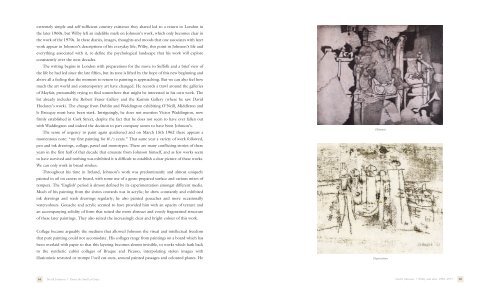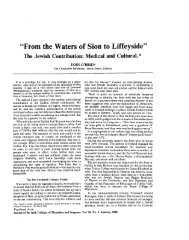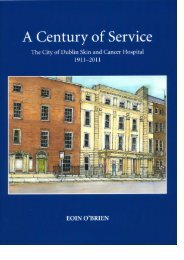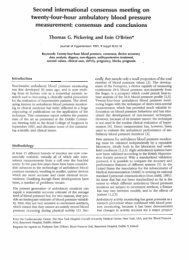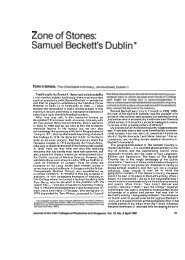Nevill Johnson: Paint the smell of grass - Eoin O'Brien
Nevill Johnson: Paint the smell of grass - Eoin O'Brien
Nevill Johnson: Paint the smell of grass - Eoin O'Brien
You also want an ePaper? Increase the reach of your titles
YUMPU automatically turns print PDFs into web optimized ePapers that Google loves.
extremely simple and self-sufficient country existence <strong>the</strong>y shared led to a return to London in<br />
<strong>the</strong> later 1960s, but Wilby left an indelible mark on <strong>Johnson</strong>’s work, which only becomes clear in<br />
<strong>the</strong> work <strong>of</strong> <strong>the</strong> 1970s. In <strong>the</strong>se diaries, images, thoughts and moods that one associates with later<br />
work appear in <strong>Johnson</strong>’s descriptions <strong>of</strong> his everyday life; Wilby, this point in <strong>Johnson</strong>’s life and<br />
everything associated with it, re-define <strong>the</strong> psychological landscape that his work will explore<br />
consistently over <strong>the</strong> next decades.<br />
The writing begins in London with preparations for <strong>the</strong> move to Suffolk and a brief view <strong>of</strong><br />
<strong>the</strong> life he had led since <strong>the</strong> late fifties, but its tone is lifted by <strong>the</strong> hope <strong>of</strong> this new beginning and<br />
above all a feeling that <strong>the</strong> moment to return to painting is approaching. But we can also feel how<br />
much <strong>the</strong> art world and contemporary art have changed. He records a trawl around <strong>the</strong> galleries<br />
<strong>of</strong> Mayfair, presumably trying to find somewhere that might be interested in his own work. The<br />
list already includes <strong>the</strong> Robert Fraser Gallery and <strong>the</strong> Kasmin Gallery (where he saw David<br />
Hockney’s work). The change from Dublin and Waddington exhibiting O’Neill, Middleton and<br />
le Brocquy must have been stark. Intriguingly, he does not mention Victor Waddington, now<br />
firmly established in Cork Street, despite <strong>the</strong> fact that he does not seem to have ever fallen out<br />
with Waddington and indeed <strong>the</strong> decision to part company seems to have been <strong>Johnson</strong>’s.<br />
The sense <strong>of</strong> urgency to paint again quickened and on March 15th 1962 <strong>the</strong>re appears a<br />
momentous note: “my first painting for 61/2 years.” That same year a variety <strong>of</strong> work followed,<br />
pen and ink drawings, collage, pastel and monotypes. There are many conflicting stories <strong>of</strong> <strong>the</strong>se<br />
years in <strong>the</strong> first half <strong>of</strong> that decade that emanate from <strong>Johnson</strong> himself, and as few works seem<br />
to have survived and nothing was exhibited it is difficult to establish a clear picture <strong>of</strong> <strong>the</strong>se works.<br />
We can only work in broad strokes.<br />
Throughout his time in Ireland, <strong>Johnson</strong>’s work was predominantly and almost uniquely<br />
painted in oil on canvas or board, with some use <strong>of</strong> a gesso-prepared surface and various mixes <strong>of</strong><br />
tempera. The ‘English’ period is almost defined by its experimentation amongst different media.<br />
Much <strong>of</strong> his painting from <strong>the</strong> sixties onwards was in acrylic; he drew constantly and exhibited<br />
ink drawings and wash drawings regularly; he also painted gouaches and more occasionally<br />
watercolours. Gouache and acrylic seemed to have provided him with an opacity <strong>of</strong> texture and<br />
an accompanying solidity <strong>of</strong> form that suited <strong>the</strong> more abstract and evenly fragmented structure<br />
<strong>of</strong> <strong>the</strong>se later paintings. They also suited <strong>the</strong> increasingly clear and bright colour <strong>of</strong> this work.<br />
Collage became arguably <strong>the</strong> medium that allowed <strong>Johnson</strong> <strong>the</strong> visual and intellectual freedom<br />
that pure painting could not accomodate. His collages range from paintings on a board which has<br />
been overlaid with paper so that this layering becomes almost invisible, to works which hark back<br />
to <strong>the</strong> syn<strong>the</strong>tic cubist collages <strong>of</strong> Braque and Picasso, interpolating stolen images with<br />
illusionistic textured or trompe l’oeil cut-outs, around painted passages and coloured planes. He<br />
64 <strong>Nevill</strong> <strong>Johnson</strong> l <strong>Paint</strong> <strong>the</strong> Smell <strong>of</strong> Grass<br />
Hismosis<br />
Deportation<br />
<strong>Nevill</strong> <strong>Johnson</strong> l Wilby and after 1959–1977 65


